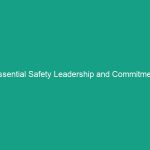Introduction
In the realm of construction, Health, Safety, and Environment (HSE) practices are vital to the well-being of workers and the successful completion of projects. As construction sites often involve a mix of different contractors and subcontractors, managing subcontractor Safety on construction sites becomes a paramount concern. The complexity of modern construction projects means that ensuring a consistent Safety standard across all parties is essential to mitigate risks and protect employees. In this article, we will delve into comprehensive strategies and tips for effectively managing subcontractor safety on construction sites, enhancing not only compliance with Regulations but also fostering a culture of safety.
Understanding Regulatory Frameworks
One of the first steps in managing subcontractor safety on construction sites is understanding the regulatory frameworks that govern Workplace Safety. In many countries, there are established regulations that dictate safety Standards for construction work. For instance, the Occupational Safety and Health Administration (OSHA) in the United States provides guidelines that all contractors must adhere to. Familiarity with these regulations is crucial for both general contractors and subcontractors, ensuring that everyone is on the same page regarding safety practices.
Key Regulations to Consider
When managing subcontractor safety, it is essential to be aware of the following regulations:
- osha Standards: These cover various aspects of construction safety, including Fall Protection, scaffolding, and hazardous materials.
- Environmental Regulations: Understanding environmental laws is key to preventing pollution and ensuring safe waste disposal on sites.
- Local Construction Codes: Many regions have specific codes that may include additional safety requirements beyond federal regulations.
Compliance and Training
Ensuring compliance with these regulations requires proper training and ongoing education. All subcontractors should receive training on the relevant safety standards before commencing work. Additionally, implementing regular refresher courses helps maintain a high level of awareness and compliance. When subcontractors understand the legal framework they operate within, they are more likely to prioritize safety in their daily activities.
Best Practices for Subcontractor Safety Management
Implementing Best Practices for managing subcontractor safety on construction sites is essential for minimizing risks and ensuring a safe work environment. Here are some key practices to consider:
1. Pre-Qualification of Subcontractors
Before engaging subcontractors, it is vital to conduct thorough pre-qualification assessments. This involves evaluating their safety record, training programs, and commitment to HSE practices. A subcontractor with a strong safety history and proactive safety culture is more likely to maintain safe working conditions. Consider asking for:
- Safety performance metrics from previous projects
- Evidence of safety training and certifications
- Subcontractor’s safety management plan
2. Clear Communication of Safety Expectations
Communication plays a critical role in managing subcontractor safety on construction sites. Clearly outline safety expectations in contracts and during project kick-off meetings. Use simple language to ensure that all subcontractors comprehend the safety protocols they must follow. Regular safety meetings can also reinforce safety messages and provide a platform for discussing safety challenges.
3. Enhanced Supervision and Oversight
Effective supervision is crucial for sustaining safety standards. Assign dedicated safety personnel who oversee subcontractor activities on-site. These individuals should conduct regular inspections and audits to ensure compliance with safety protocols. When subcontractors know that their work is being monitored, they are more likely to adhere to safety standards.
4. Incident Reporting and Response
Establishing a clear incident reporting and response protocol is essential. All subcontractors should be aware of the Procedures for reporting near misses, accidents, and unsafe conditions. Prompt reporting allows for swift corrective actions, thereby preventing future incidents. Furthermore, analyzing incident reports helps identify patterns or recurring issues that may need addressing.
5. Continuous Improvement Culture
Encouraging a culture of continuous improvement is vital for long-term safety management. Solicit feedback from subcontractors regarding safety practices and involve them in safety committees or discussions. By fostering a collaborative environment, you empower subcontractors to contribute to safety solutions, ultimately enhancing safety performance across the site.
Case Studies: Successful Subcontractor Safety Management
Examining real-world examples can provide valuable insights into effective strategies for managing subcontractor safety on construction sites. Here are two notable case studies:
Case Study 1: Large Infrastructure Project
On a recent large infrastructure project, the general contractor implemented a rigorous subcontractor pre-qualification process that included safety training and background checks. This approach ensured that only subcontractors with strong safety records were hired. Throughout the project, regular safety audits were conducted, resulting in a 30% decrease in workplace incidents compared to previous projects. The contractor also organized monthly safety forums where subcontractors shared their experiences and Best Practices, fostering a culture of collaboration and learning.
Case Study 2: Residential Construction
A residential construction company faced challenges with subcontractor safety compliance. To address this, they introduced a comprehensive onboarding program that included safety training specific to their projects. They also established a reward system for subcontractors who maintained excellent safety records. This initiative not only improved safety compliance but also enhanced subcontractor morale, leading to a more engaged workforce. Over the course of the project, incidents were reduced by 50%, demonstrating the effectiveness of proactive safety management.
Challenges in Managing Subcontractor Safety
While there are numerous strategies for managing subcontractor safety on construction sites, several challenges can arise:
1. Diverse Safety Cultures
Different subcontractors may have varying safety cultures, which can lead to inconsistencies on-site. General contractors must work to bridge these gaps by fostering a unified safety culture that aligns all parties.
2. Communication Barriers
Language differences or miscommunication can hinder effective safety management. Utilizing visual aids and multilingual safety materials can help overcome these barriers.
3. Resource Limitations
Some subcontractors may lack the resources to implement robust safety programs. General contractors can assist by providing access to training and safety tools, ensuring that all subcontractors have the means to comply with safety standards.
Future Trends in Subcontractor Safety Management
As the construction industry evolves, so too do the approaches to managing subcontractor safety on construction sites. Here are some trends to watch:
1. Technology Integration
Advancements in technology are transforming safety management. Tools such as drones for site inspections, wearable safety devices, and mobile apps for incident reporting are becoming more common. These technologies enhance real-time monitoring and improve response times to safety issues.
2. Focus on Mental Health
Recognizing the importance of mental health in the workplace is gaining momentum. Programs that support mental well-being can reduce stress and improve overall safety performance. General contractors should consider integrating mental health resources into their safety management plans.
3. Sustainability and Safety
There is a growing awareness of the relationship between Sustainability and safety. Sustainable construction practices often require innovative safety solutions. Emphasizing sustainable Safety Measures can lead to safer and more environmentally friendly construction sites.
Conclusion
In conclusion, managing subcontractor safety on construction sites is a multifaceted challenge that requires a proactive approach, adherence to regulations, and a commitment to continuous improvement. By implementing best practices, fostering communication, and leveraging technology, general contractors can create a safer work environment for everyone involved. The importance of HSE cannot be overstated; it is not just about compliance but about ensuring the well-being of all workers on-site. As we move forward, let’s prioritize safety and work together to build a safer future in construction. Take action today by reviewing your current safety management practices and making necessary adjustments to protect your workforce.


